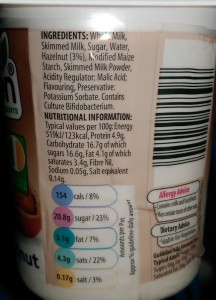An Explanation of the New EU Labelling Laws for Allergens
Food labelling can be very confusing when you are trying to avoid a certain food item. I’ve written before about the many different names that can indicate forms of dairy. New EU legislation means that from December 2014 allergy labelling will be standardised and in a particular format. This is good news for the allergy community. The Food Safety Authority of Ireland have produced a booklet entitled: Overview of Changes to Food Labelling Introduced under the New Food Information Regulation. This is a helpful interpretation of the new laws.
Here’s what the FSAI booklet says about the Allergen changes:
Allergens
Currently, all pre-packaged food products must indicate on the label the presence in their product of specific ingredients which the EU has identified as causing allergic reactions in certain people or to which individuals can be intolerant to. This list of substances remains the same as that in the current rules (see Annex II of Regulation (EU) No 1169/2001 for the list*). However, under the new rules, they must now be indicated in the list of ingredients and the name of the substance must be emphasised through a typeset that clearly distinguishes it from the rest of the list of ingredients, e.g. by means of the font, style or background colour.
For pre-packaged foods which are exempt from the requirement to provide a list of ingredients, e.g. alcohol, the indication on the label must comprise of the word ‘contains’ followed by the name of the substance or product as listed in Annex II to the Regulation. Under the new rules, the requirement to highlight the use of any of these substances in the production of a foodstuff has been extended to foods sold loose such as food in restaurants, take-aways, canteens and deli counters etc. Rules on the means by which this information must be made available to the consumer for foods sold loose, must be introduced by each Member State.
What does this mean?
It means that from now on all food packages must highlight all allergens in the ingredient list. This means the allergen ingredients will be underlined, in italics, in bold or highlighted in a different colour. It also means that the Contains/Allergy Advice box is no longer allowed (unless it says ‘For Allergen information see ingredients in bold‘). This is to stop the allergen information being repeated on the label. Also, the ‘Contains/Allergy Advice’ box was volutary so it didn’t appear on all labels, maybe leading you to believe something was safe that wasn’t really. Once the new packaging is widespread, we will be able to check the ingredients list and spot the allergens immediately. The ‘may contains’ labelling will remain unchanged.
Here is an example of the old labelling:

The ingredients list is all written in the same font and no ingredients are highlighted. The allergy advice below the ingredients states that the product contains Milk and Nuts. By December 2014 all labelling like this will have to be changed. Any allergen will have to be highlighted (usually by being in bold) in the list of ingredients. There is also an Allergy Advice box, from December 2014 this kind of box will no longer be allowed.
And here is an example of the new labelling:
Note that the milk ingredients are written in bold as they are allergens and note for Allergy Advice it just says ‘For allergens, see ingredients in bold.
This is extremely important for non obvious allergens such as whey powder or rennet as forms of dairy. Consumers will be able to read the list and immediately identify which ingredients are allergens.

Another very important and welcome change in the December 2014 amendments is that from now on any foods sold even if sold loose or at a deli, will have to have allergen information readily available and accessible. It will not be enough just to be able to ask for these details, they must be easily available. This is an important one as usually delis and market stalls etc. are a complete no go area as you can never be sure what the products contain.
When will all this happen?
All producers need to comply by 13th December 2014. Where they have products produced before December 2014 with the old packaging, that produce can be sold until the stock is sold out. I’ve already noticed many products with the new labelling. It will be a good positive change overall for helping to spot allergens.
*Annex II of Regulation (EU) No 1169/2001
SUBSTANCES OR PRODUCTS CAUSING ALLERGIES OR INTOLERANCES
1. Cereals containing gluten,
2. Crustaceans and products thereof;
3. Eggs and products thereof;
4. Fish and products thereof,
5. Peanuts and products thereof;
6. Soybeans and products thereof,
7. Milk and products thereof (including lactose),
8. Nuts
9. Celery and products thereof;
10. Mustard and products thereof;
11. Sesame seeds and products thereof;
12. Sulphur dioxide and sulphites;
13. Lupin and products thereof;
14. Molluscs and products thereof.
All information taken from the FSAI website.

